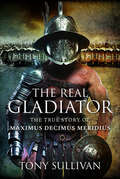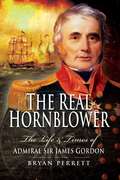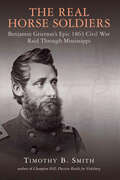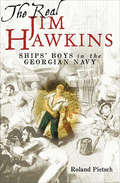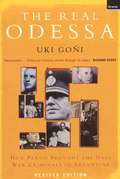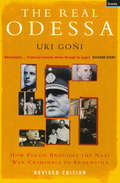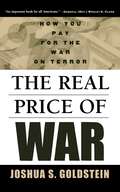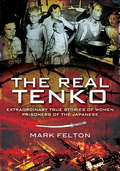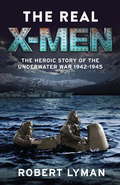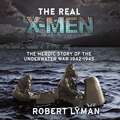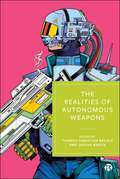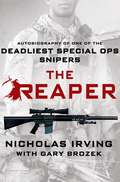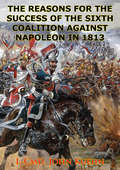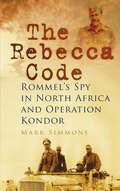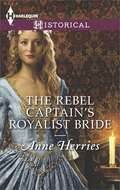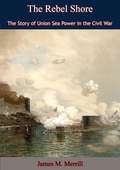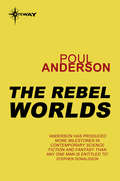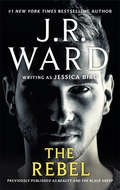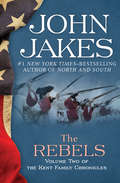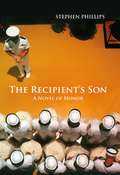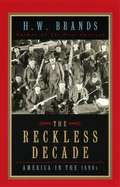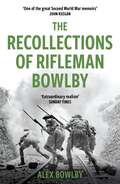- Table View
- List View
The Real Gladiator: The True Story of Maximus Decimus Meridius
by Tony Sullivan“Are you not entertained?” shouts Russell Crowe, playing the part of General Maximus Decimus Meridius in the Oscar winning 2000 film Gladiator. The crowd, having witnessed Maximus defeating several gladiators, cheer in response. Film goers too were indeed entertained with the film grossing nearly half a billion dollars. This book covers the historical events that film was based on. From the Germanic wars on the northern frontier to the gladiatorial arena in Rome. From the philosopher emperor, Marcus Aurelius to the palace intrigues during the reign of his son. We will discover how Commodus really died and which of the characters actually fought in the arena. Readers will meet two generals, Pompeianus and Maximianus, who most resemble our hero General Maximus. Also Lucilla, the sister of Commodus, who in reality married her General, but detested him. The book also focuses on warfare, weapons and contemporary battles. It will compare the battle and fight scenes in the film with reality from contemporary sources and modern tests and reenactments. The reader will discover that fact is not only stranger than fiction, it is often more entertaining. The real history was certainly as much, if not more, treacherous, bloodthirsty, murderous and dramatic than anything the film industry has created. Anyone who answered “yes!” to the question posed by Russell Crowe’s character in the film, will indeed be entertained by this book.
The Real Hornblower: The Life and Times of Admiral Sir James Gordon
by Bryan PerrettFirst published in 1997, The Real Hornblower offers a comprehensive and engaging account of the life and times of this great naval admiral. Ever since C.S. Forester's fictional hero Horatio Hornblower began to delight and enthral readers, there has been speculation as to whether his adventures were based on the career of a real naval officer. Several names were suggested; the general conclusion was that Hornblower was a composite character.However, while researching the campaign that resulted in the burning of Washington's public buildings, Bryan Perrett consulted Forester's Naval War of 1812 and was surprised to discover that the author had been deliberately reticent regarding a Captain James Alexander Gordon, RN, who had led his squadron up the Potomac. Further inspection of naval records revealed a startling number of parallels between the careers of Gordon and Hornblower. Subsequent research spanning a period of ten years uncovered yet more similarities - too many, in fact, to be a matter of simple coincidence. It became apparent that, while Forester certainly included other episodes in the Hornblower cycle, he was aware of Gordonwhen the first of his books were written, and that when he decided to expand the series he chose Gordon's career as the framework on which his hero's life would be based.As a professional author, it was neither surprising that he should conceal the fact, nor that he should choose Gordon as his model. Gordon had entered the Royal Navy as a semi-literate eleven-year-old and rose to become Admiral of the Fleet. He took part in major sea battles, frigate actions, single-ship duels and operations far behind enemy lines. It was the fire of his ships, directed against Fort McHenry, Baltimore, that inspired the National Anthem. He was the last Governor of the Royal Naval Hospital at Greenwich, and when he died, having served for more than seventy five years in the Navy, The Timescommented that he was' the last of Nelson's captains'. That he should have attracted Forster's attention is not, therefore, surprising. In telling the largely unknown story of Admiral Gordon's active service career, Bryan Perrett has produced a book that will be appreciated by the thousands of readers who have enjoyed the adventures of Horatio Hornblower and his successors. It will also be welcomed by anyone with an interest in the naval warfare of the Napoleonic era, while those who take pleasure in biography will find that they have the added bonus of an absorbing literary and historical detective story.
The Real Horse Soldiers: Benjamin Grierson’s Epic 1863 Civil War Raid Through Mississippi
by Timothy B. Smith“This epic account is as thrilling and fast-paced as the raid itself and will quickly rival, if not surpass, Dee Brown’s Grierson’s Raid as the standard.” —Terrence J. Winschel, historian (ret.), Vicksburg National Military ParkWinner, Operational/Battle History, Army Historical Foundation Distinguished Book AwardWinner, Fletcher Pratt Literary Award, Civil War Round Table of New YorkThere were other simultaneous operations to distract Confederate attention from the real threat posed by U. S. Grant’s Army of the Tennessee. Benjamin Grierson’s operation, however, mainly conducted with two Illinois cavalry regiments, has become the most famous, and for good reason: For 16 days (April 17 to May 2) Grierson led Confederate pursuers on a high-stakes chase through the entire state of Mississippi, entering the northern border with Tennessee and exiting its southern border with Louisiana. Throughout, he displayed outstanding leadership and cunning, destroyed railroad tracks, burned trestles and bridges, freed slaves, and created as much damage and chaos as possible.Grierson’s Raid broke a vital Confederate rail line at Newton Station that supplied Vicksburg and, perhaps most importantly, consumed the attention of the Confederate high command. While Confederate Lt. Gen. John Pemberton at Vicksburg and other Southern leaders looked in the wrong directions, Grant moved his entire Army of the Tennessee across the Mississippi River below Vicksburg, spelling the doom of that city, the Confederate chances of holding the river, and perhaps the Confederacy itself.Based upon years of research and presented in gripping, fast-paced prose, Timothy B. Smith’s The Real Horse Soldiers captures the high drama and tension of the 1863 horse soldiers in a modern, comprehensive, academic study. Readers will find it fills a wide void in Civil War literature.
The Real Jim Hawkins: Ships' Boys in the Georgian Navy
by Roland PietschGenerations of readers have enjoyed the adventures of Jim Hawkins, the young protagonist and narrator in Robert Louis Stevensons Treasure Island, but little is known of the real Jim Hawkins and the thousands of poor boys who went to sea in the eighteenth century to man the ships of the Royal Navy. This groundbreaking new work is a study of the origins, life and culture of the boys of the Georgian navy, not of the upper-class children training to become officers, but of the orphaned, delinquent or just plain adventurous youths whose prospects on land were bleak and miserable. Many had no adult at all taking care of them; others were failed apprentices; many were troublesome youths for whom communities could not provide so that the Navy represented a form of floating workhouse. Some, with restless and roving minds, like Defoes Robinson Crusoe, saw deep sea life as one of adventure, interspersed with raucous periods ashore drinking, singing and womanizing. The author explains how they were recruited; describes the distinctive subculture of the young sailor the dress, hair, tattoos and language and their life and training as servants of captains and officers.More than 5,000 boys were recruited during the Seven Years War alone and without them the Royal Navy could not have fought its wars. This is a fascinating tribute to a forgotten band of sailors.
The Real Odessa: How Peron Brought The Nazi War Criminals To Argentina
by Uki GoniIt has long been known that Adolf Eichmann, Josef Mengele, Erich Priebke and many other Nazi war criminals found refuge in Argentina. In this book, a courageous Argentinian writer shows exactly how it was done, and reveals that the escapes were organized with the enthusiastic support of President Juan Peron. Even at this late date, when so much is known about the complicity of the Catholic Church and Allied intelligence agencies in the flight of the Nazis, Goni's material still has the power to shock. The paperback edition of The Real Odessa includes a revised introduction and conclusion, with a new afterword containing material that Uki Goni has recently researched and which focuses on Vatican complicity in providing sanctuary for war criminals.
The Real Odessa: How Perón Brought the Nazi War Criminals to Argentina
by Uki GoñiThe history of President Peron&’s conspiracy to protect Nazi war criminals: &“a chilling, detailed story of one of Argentina&’s most shameful secrets&” (Foreign Affairs). It has long been known that, after the Allied victory of World War II, Adolf Eichmann, Josef Mengele, Erich Priebke and many other Nazi war criminals found refuge in Argentina. In this book, Argentinian historian Uki Goni reveals the complex networks that made their escapes possible—and demonstrates that the operation was organized with the enthusiastic support of President Juan Peron. Even at this late date, when so much is known about the complicity of the Catholic Church and Allied intelligence agencies in the flight of the Nazis, Goni&’s historical revelations are truly shocking. This edition of The Real Odessa includes a revised introduction and conclusion, with a new afterword containing material that focuses on the Vatican&’s complicity in providing sanctuary for war criminals.
The Real Price of War: How You Pay for the War on Terror
by Joshua S. GoldsteinCalculates and expounds on the costs to individual Americans of the War on TerrorAre Americans in denial about the costs of the War on Terror? In The Real Price of War, Joshua S. Goldstein argues that we need to face up to what the war costs the average American—both in taxes and in changes to our way of life. Goldstein contends that in order to protect the United States from future attacks, we must fight—and win—the War on Terror. Yet even as President Bush campaigns on promises of national security, his administration is cutting taxes and increasing deficit spending, resulting in too little money to eradicate terrorism and a crippling burden of national debt for future generations to pay.The Real Price of War breaks down billion-dollar government expenditures into the prices individual Americans are paying through their taxes. Goldstein estimates that the average American household currently pays $500 each month to finance war. Beyond the dollars and cents that finance military operations and increased security within the U.S., the War on Terror also costs America in less tangible ways, including lost lives, reduced revenue from international travelers, and budget pressures on local governments. The longer the war continues, the greater these costs. In order to win the war faster, Goldstein argues for an increase in war funding, at a cost of about $100 per household per month, to better fund military spending, homeland security, and foreign aid and diplomacy.Americans have been told that the War on Terror is a war without sacrifice. But as Goldstein emphatically states: “These truths should be self-evident: The nation is at war. The war is expensive. Someone has to pay for it.”
The Real Tenko: Extraordinary True Stories of Women Prisoners of the Japanese
by Mark FeltonThis book details the treatment of Allied service-women, female civilians and local women by the Japanese occupation forces. While a number of memoirs have been published there is no dedicated volume. It chronicles the massacres of nurses (such as that at Alexandra Hospital, Singapore), disturbing atrocities on both Europeans and Asians, and accounts of imprisonment. It reveals how many ended up in Japanese hands when they should have been evacuated. Also covered are the hardships of long marches and the sexual enslavement of white and native women (so called 'Comfort Women'). The book is a testimony both to the callous and cruel behavior of the Japanese and to the courage and fortitude of those who suffered at their hands.
The Real X-Men: The Heroic Story of the Underwater War 1942–1945
by Robert LymanThe thrilling and true story of the development and operational deployment of human torpedoes - 'Chariots' - and 'X-craft' midget submarines in British naval service during WWII, and of the extraordinary men who crewed these dangerous vessels. The commando frogmen who rode the Chariots and operated as divers from the X-craft were the forerunners of today's Special Boat Service, the SBS. Their aim was to attach an explosive charge underneath an enemy ship to destroy the vessel. Their hope was to return to their submarine unscathed. The Real X-Men tells the story of the sacrifice and heroism of the individual men, many of them little more than teenagers, who volunteered for this dangerous duty and who crewed both the Chariots and the X-craft without knowing the full extent of the risks entailed, nor indeed the very small chances they had of coming back alive.
The Real X-Men: The Heroic Story of the Underwater War 1942–1945
by Robert LymanThe thrilling and true story of the development and operational deployment of human torpedoes - 'Chariots' - and 'X-craft' midget submarines in British naval service during WWII, and of the extraordinary men who crewed these dangerous vessels. The commando frogmen who rode the Chariots and operated as divers from the X-craft were the forerunners of today's Special Boat Service, the SBS. Their aim was to attach an explosive charge underneath an enemy ship to destroy the vessel. Their hope was to return to their submarine unscathed. X-Men tells the story of the sacrifice and heroism of the individual men, many of them little more than teenagers, who volunteered for this dangerous duty and who crewed both the Chariots and the X-craft without knowing the full extent of the risks entailed, nor indeed the very small chances they had of coming back alive.(P)2015 WF Howes Ltd
The Realities of Autonomous Weapons
by Thomas Christian Bächle and Jascha BareisAvailable open access digitally under CC-BY-NC-ND licence. The realities of autonomous weapons are a complex blend of both existing military technologies and visions of their future capabilities. The expected ramifications are profound and always point to the interplay between fact and fiction, actual developments and creative imagination. This book explores how these realities shape and become themselves shaped by popular culture, regulatory and ethics debates, military doctrines, policies and research. It examines phenomena ranging from film and artistic interpretations to warfare scenarios and weaponized artificial intelligence. Intended for researchers (including the disciplines of political and social sciences, media, culture and technology), policy makers, educators and journalists, this is a key resource that uncovers how autonomous weapons are constructed as both a technological reality and a futuristic possibility.
The Reaper: Autobiography Of One Of The Deadliest Special Ops Snipers
by Gary Brozek Nicholas IrvingGroundbreaking, thrilling and revealing, The Reaper is the astonishing memoir of Special Operations Direct Action Sniper Nicholas Irving, the 3rd Ranger Battalion's deadliest sniper with 33 confirmed kills, though his remarkable career total, including probables, is unknown.<P><P> Irving shares the true story of his extraordinary military career, including his deployment to Afghanistan in the summer of 2009, when he set another record, this time for enemy kills on a single deployment. His teammates and chain of command labeled him "The Reaper," and his actions on the battlefield became the stuff of legend, culminating in an extraordinary face-off against an enemy sniper known simply as The Chechnian.<P> Irving's astonishing first-person account of his development into an expert assassin offers a fascinating and extremely rare view of special operations combat missions through the eyes of a Ranger sniper during the Global War on Terrorism. From the brotherhood and sacrifice of teammates in battle to the cold reality of taking a life to protect another, no other book dives so deep inside the life of an Army sniper on point.
The Reasons For The Success Of The Sixth Coalition Against Napoleon In 1813
by Commander John Trost KuehnThis study investigates the reasons for the success of the Sixth Coalition against Napoleon in 1813. Four critical principles emerge from U.S. joint doctrine that provide a means to examine coalition warfare: national goals, unity of effort, strategic plans, and adherence to plans. These principles illuminate the primary importance of coalition warfare in the defeat of Napoleon.The failure of an earlier coalition the Second Coalition in 1799 underscores the importance of the principles of coalition warfare to the success or failure of the coalitions against Napoleon and the French. This coalition failed because of its lack of attention to the details of coalition warfare. Its basic flaw, lack of a common coalition goal, undermined its unity and resulted in defeat.The development of a common goal, the liberation of Germany, combined with the decline of the French and reforms by Napoleon's opponents led to a level playing field 1813. The 1813 spring campaign resulted in a stalemate. The coalition used the subsequent armistice to further improve their coalition both politically and militarily. These improvements, particularly the adoption of a unified military strategy, resulted in improved unity of effort and provided the coalition the margin for ultimate victory.
The Rebecca Code: Rommel's Spy in Africa and Operation Condor
by Mark SimmonsJohn Eppler thought himself to be the perfect spy. Born to German parents, he grew up in Egypt, adopted by a wealthy family and was educated in Europe. Fluent in German, English and Arabic, he made the Hadj to Mecca but was more at home in high society or travelling the desert on camelback with his adopted Bedouin tribe. After joining the German Secret Service in 1937, in 1942 he was sent across the desert to Cairo by Field Marshal Rommel. His guide was the explorer and Hungarian aristocrat Laszlo Almasy, a man made famous by the book The English Patient. Eppler’s mission was to infiltrate British Army Headquarters and discover the Eighth Army’s troop movements and battle plans. In The Rebecca Code, Mark Simmons reveals the story of Operation Condor and its comedy of errors and how it was foiled by Major A.W. ‘Sammy’ Sansom of the British Field Security Service. It is a tale of the desert, of the hotbed of intrigue that was 1940s Cairo, and the spy who was to send his reports using a code based on Daphne du Maurier’s novel Rebecca.
The Rebel Captain's Royalist Bride
by Anne HerriesLOVE THINE ENEMY... Orphaned and without protection, Babette Harvey must suffer in silence when her uncle gives shelter to a band of Rebels-though her Royalist blood boils! But other dangerous passions must also be quieted-including those aroused by the handsome and commanding Rebel leader Captain James Colby. When Babette's talent for herbal medicine attracts suspicions of witchcraft, she has nowhere to turn save to Colby-her honorable enemy. And with the captain determined to claim her as his bride, Babette must choose which to betray-her principles or her heart. "Another enjoyable romp." -RT Book Reviews on An Innocent Debutante in Hanover Square
The Rebel Cowboy's Baby: A Clean Romance (The Cowboys of Garrison, Texas #1)
by Sasha SummersCan a wild cowboy prove…He's daddy material? Rodeo cowboy Audy Briscoe loves getting into trouble. If he can't charm his way into beautiful and straitlaced Brooke Young's heart, then he'll settle for rilin' her up but good! When a terrible tragedy leaves them co-guardians of a baby girl, Audy finds himself in over his head. Is it too late to turn this restless rebel cowboy into the kind of man—and father—Brooke could love?The Cowboys of Garrison, TexasBook 1: The Rebel Cowboy's BabyBook 2: The Wrong CowboyBook 3: To Trust a Cowboy
The Rebel Shore: The Story of Union Sea Power in the Civil War
by James M. MerrillFirst published in 1957, this book details the important part that the sea power played in winning the Civil War.“IN the past few decades there has been a resurgence of interest in the Civil War reflected in an avalanche of Civil War novels, biographies, and monographs. The writers responsible for this torrent have for the most part focused attention on the battlefields, the halls of Congress, the economics of war, and the actors, big and small. The role of sea power has been minimized. The best work on Civil War naval operations is still Boynton’s two-volume work published in 1867. No author to date has sifted the countless number of official naval dispatches or unearthed personal correspondence of Yankee bluejackets and attempted to evaluate the importance of Lincoln’s forces afloat. The reason is not difficult to find. The Civil War generation—a generation weaned on the marching armies of the Mexican War and the American West—read column after column in its newspapers and listened to politicians in and out of Congress raving about the military achievements or defeats. Misunderstood by the Lincoln Administration, the war correspondents, and the public at large, the operations of the Union sea arm were given scant publicity.“Union amphibious attacks spearheaded the offensive. They were, perhaps, more significant than the blockade itself. Old Abe’s Armada carried the flag first into the South, secured needed bases for the blockading squadrons, wiped out Confederate coastal commerce, scotched privateering activities, precipitated the ruckus between the secessionist states and the Confederate Government, and, throughout the first year of the conflict, while the Union Army licked its wounds after Bull Run, buoyed up a sagging Northern spirit and strengthened the belief that the Union could crush the rebellion.”
The Rebel Worlds: A Flandry Book
by Poul AndersonThe barbarians in their long ships waiting at the edge of the Galaxy waited for the ancient Terran Empire to fall, while two struggled to save it: ex-Admiral McCormac, forced to rebel against a corrupt Emperor, and Starship Commander Flandry, the brilliant young officer who served the Imperium even as he scorned it.Trapped between them was the woman they both loved, but couldn't share: the beautiful Kathryn - whose single word could decide the fate of a billion suns.
The Rebel: The Rebel The Player The Renegade The Rogue (The\moorehouse Legacy Ser.)
by J. R. WardOnly one woman can tame him…. Experience the first book in the Moorehouse Legacy series from New York Times bestselling author J.R. Ward writing as Jessica Bird, first published as Beauty and the Black Sheep!Entrepreneur Nate Walker does whatever it takes to carve out his place in life. After rejecting his family’s legacy and losing a gold-digging fiancé in the process, it’s just him, his chef knives and his trusty old car on the road to developing a five-star restaurant… until the trusty old car breaks down in the Adirondacks, leading him right to White Caps Inn… and Frankie Moorehouse.Suddenly Nate has a job he doesn’t really need—and an affair that has to end when summer does. Except Frankie has a way about her. She gets under his skin. She even makes him want to do what he never thought he could: stay forever.Originally published in 2005
The Rebels (The Kent Family Chronicles #2)
by John JakesPhilip Kent fights for his new country during the Revolutionary War, in the historical family saga from the #1 New York Times–bestselling author. The engrossing follow-up to The Bastard finds Philip Kent standing as a Continental solider at the Battle of Bunker Hill. In a bold move, Kent has taken up arms for the future of his new family. Spirited and unwavering in his dedication to his adopted homeland, Kent fights in the most violent battles in America&’s early history. As the Revolution rages, Kent&’s story interweaves with the trials of a vivid cast of characters, both famous and unknown. The result is a tautly plotted epic novel that transports the reader into the thrilling adventure of a man&’s fight for a new life. This ebook features an illustrated biography of John Jakes including rare images from the author&’s personal collection.
The Rebirth of Italian Communism, 1943–44: Dissidents in German-Occupied Rome
by David BroderDuring the final years of the Second World War, a decisive change took place in the Italian left, as the Italian Communist Party (PCI) rose from clandestinity and recast itself as a mass, patriotic force committed to building a new democracy. This book explains how this new party came into being. Using Rome as its focus, it explains that the rebirth of the PCI required that it subdue other, dissident strands of communist thinking. During the nine-month German occupation of Rome in 1943-44, dissident communists would create the capital’s largest single resistance formation, the Communist Movement of Italy (MCd’I), which galvanised a social revolt in the capital's borgate slums. Exploring this wartime battle to define the rebirth of Italian communism, the author examines the ways in which a militant minority of communists rooted their activity in the everyday lives of the population under occupation. In particular, this study focuses on the role of draft resistance and the revolt against labour conscription in driving recruitment to partisan bands, and how communist militants sought to mould these recruits through an active effort of political education. Studying the political writing of these dissidents, their autodidact Marxism and the social conditions in which it emerged, this book also sheds light on an often-ignored underground culture in the years that preceded the armed resistance that began in September 1943. Revealing an almost unknown history of dissident communism in Italy, outside of more recognisable traditions like Trotskyism or Bordigism, this book provides an innovative perspective on Italian history. It will be of interest to those researching the broad topics of political and social history, but more specifically, resistance in the Second World War and the post-war European left.
The Recipient's Son
by Stephen PhillipsThe names solemnly displayed in Memorial Hall at the U.S. Naval Academy serve as a constant reminder of why Annapolis is different from Harvard, or Stanford, or Duke. No midshipman recognizes this more viscerally than Donald Durago, who knows all too well that some will die--heroically, tragically, slowly, or quickly--in the service of their country.Set at the U.S. Naval Academy in the 1990s, The Recipient's Son tells the story of a young man's struggle to come to terms with his legacy as the son of a war hero and with his doubts about his own courage. Durago's father was killed in the Vietnam War where his actions as a POW earned him the Medal of Honor. That honor provided Durago with an appointment to the Naval Academy, a benefit offered to all children of Medal of Honor recipients.During his plebe year, Durago struggles under the burden of being worthy of his father's memory. With the help of Master Chief Strong, he begins to identify with his father's sacrifice, his own naval heritage, and Academy life. When an incident during his senior year brings his character into question triggering terrifying nightmares Durago realizes he has not completely dealt with his father's death. Before he can graduate, he must defend himself at a board of inquiry and faces "separation," a fate worse than mere expulsion. However, with the support of his roommate and a pretty JAG officer he finds the confidence to pursue a military career. The Recipient's Son is a stirring tale of a young man coming to grips with the heroism of his father and overcoming his self-doubts to accept the challenge of serving his country on his own terms.
The Reckless Decade: America in the 1890s
by H. W. BrandsA famous historian demonstrates that one can learn a lot about the contradictions that lie at the heart of America today by looking at them through the lens of the 1890s.
The Recollections Of Rifleman Bowlby (W&N Military)
by Alex Bowlby'One of the great Second World War memoirs ... will be read as long as that war is remembered' John Keegan'Extraordinary realism' SUNDAY TIMES'A touch of the Somme and more than a hint of Wilfred Owen' TLSA classic of WWII, this is the vivid memoir of Private Bowlby, who came through the North Africa campaign only to have to battle in bitter fighting against a stubborn and skilled German defence in Italy. It is a truly authentic account of what it was like to fight your way through one of the most gruelling and dangerous campaigns of the Second World War, where so often the hunters became the hunted.A superb first-hand account of the the second world war.
The Recollections Of Rifleman Bowlby (W&N Military)
by Alex Bowlby'One of the great Second World War memoirs ... will be read as long as that war is remembered' John Keegan'Extraordinary realism' SUNDAY TIMES'A touch of the Somme and more than a hint of Wilfred Owen' TLSA classic of WWII, this is the vivid memoir of Private Bowlby, who came through the North Africa campaign only to have to battle in bitter fighting against a stubborn and skilled German defence in Italy. It is a truly authentic account of what it was like to fight your way through one of the most gruelling and dangerous campaigns of the Second World War, where so often the hunters became the hunted.A superb first-hand account of the the second world war.
